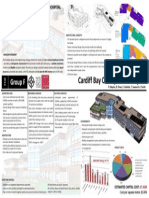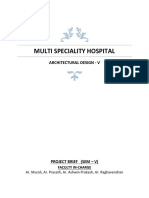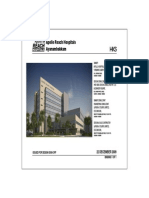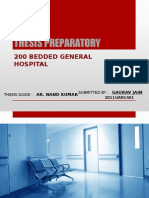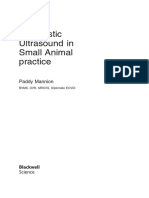Case Study On Hospital
Case Study On Hospital
Uploaded by
AbhishekGaurCopyright:
Available Formats
Case Study On Hospital
Case Study On Hospital
Uploaded by
AbhishekGaurOriginal Description:
Original Title
Copyright
Available Formats
Share this document
Did you find this document useful?
Is this content inappropriate?
Copyright:
Available Formats
Case Study On Hospital
Case Study On Hospital
Uploaded by
AbhishekGaurCopyright:
Available Formats
REPORT ON
MULTI-SPECIALITY
HOSPITAL
SUBMITTED BY:
NIKITA GUPTA
A51204011037
B.ARCH
6
TH
SEMESTER
SUB: ARCHITECTURE DESIGN
Amity School of Architecture and Planning
Amity University Haryana
ABSTRACT
CONTENTS
INTRODUCTION 1
CHAPTER-1
1.1 INTRODUCTION OF HOSP ITAL 2
CHAPTER-2
2.1 CASE STUDY
2.1.1 CASE STUDY FORTIS HOSPITAL 3
2.1.2 CLIMATIC CONDITIONS 4
2.1.3 MATERIALS USED IN CONSTRUCTION 4
2.1.4 STRATERGIES WERE ADOPTED TO REDUCE 4-5
THE BUILDING IMPACT ON THE NATURAL ENVIRONMENT
2.1.5 FLOOR PLANS 6
2.1.6 REQUIREMENTS OF FORTIS HOSPITAL 6-7
2.1.7 DISABLED FACILITIES 9
2.1.8 BUILDING SERVICES 9-10
2.1.9 PNEUMATIC TUBE SYSTEM 10-11
2.1.10 STANDARDS AND NORMS 11-14
INFERENCE 15
REFERENCES
INTRODUCTION
OBJECTIVE
The objective of this report is to develop an understanding of the meaning of the multi-specialty
hospital, its functioning and the requirements.
APPLICATION
The application of this report aims at giving a broad view of hospitals designs and construction.
Also, a case study of a hospital would further help to understand the ideas behind its functioning
and designing.
METHODOLOGY ADOPTED
The methodology adapted to the completion of this report is divided into following phases:
Phase I
Literature survey by collection of data from sources like various books available in the
college library or on the internet and knowledge gathered from various websites.
This phase also includes in practically visiting the hospital.
Phase II
Thereafter, the data so collected was sorted out accordingly and studied thoroughly so as
to extrapolate the relevant information. The information was then compiled.
Phase III
After compiling the information the discussion and drawing of conclusion was made.
Phase IV
The last phase of this report comprised of compiling the study carried out so far.
1
CHAPTER-1
1.1 INTRODUCTION
A hospital is a health care institution providing patient treatment by specialized staff
equipment
[1]
. In accord with the original meaning of the word hospital were originally
places of hospitality. Hospitals are usually distinguished from other types of medical
facilities by their ability to admit and care for inpatients.
The best known type of hospital is the one which is set up to deal with many kinds of disease
and injury and normally has an emergency department to deal with immediate and urgent
threats to health. The hospital buildings are designed to minimize the effort of medical
personnel and possibility of contamination while maximizing the efficiency of the whole
system.
A multi-specialty hospital is a hospital which provides various facilities like cardiac,
urology, diabetic etc. and what not under the same roof
[2]
. The main advantage of this
hospital is that patient need to rush from one hospital to another for varied diseases, saving
time, manpower and money.
2
CHAPTER-2
2.1 CASE STUDY
2.1.1 CASE STUDY OF FORTIS HOSPITAL
[3]
LOCATION: SECTOR- 44, GURGAON, HARYANA
3
2.1.2 CLIMATIC CONDITIONS
DELHI
[4]
Monsoon influenced humid subtropical
It has high variation between summer and winter temperature and precipitation
Since, Haryana is near to Delhi, so the climatic conditions are similar to both the states.
HARYANA
[5]
The climatic conditions are similar to other states of India lying in northern plains.
Very hot in summer
Cold in winter
Rainfall is varied, since, the Aravalli hills region being the driest.
FLORA AND FAUNA IN HARYANA
[6]
Thorny, dry, deciduous forests and thorny shrubs.
2.1.3 MATERIALS USED IN CONSTRUCTION
Steel Structure: It is used in the construction work so as to carry load according
to the height of the structure.
Glass: It is used for the lighting ventilation in the building.
Brick Work
Roof style: Near the reception area lounge, in the roof, skylights are used for
natural lighting.
2.1.4 STRATERGIES WERE ADOPTED TO REDUCE THE BUILDING
IMPACT ON THE NATURAL ENVIRONMENT
[7]
Sustainable site planning:
Top soil from the site, which was not very fertile was stacked, preserved, made fertile with the
addition of manure and re-laid on the landscape areas.
Consolidation of all site services along the transportation corridors minimizes the site
disturbances.
4
Surface parking is provided with 100% grass pavers reduce the heat island effect on site.
Sufficient plantation done at the site reduces the noise levels considerably and enhances
exterior environmental quality.
Reduction in water consumption (compared to GRIHA benchmark):
Low flow plumbing fixtures used to minimize the building water consumption reduction by
63%.
Drip Irrigation system adopted on the site along with native plant species to cut short the
landscape water consumption by 50%.
100% Treated water from sewage treatment plant is reused for cooling towers and irrigation
purposes.
Reduction in energy consumption (compared to GRIHA benchmark) while
maintaining occupant comfort:
For achieving visual comfort
Ingress of daylight in Patient areas &Waiting areas.
Landscape in sync with the Architectural spaces to provide visual comfort.
For achieving thermal comfort
Use of AAC blocks, Double Glazing & Roof insulation.
Renewable energy technologies installed on site:
Solar Photovoltaic Panels for 25 KWp are installed at site.
Solar Water Heaters for 8000 litres are also installed to meet the surplus hot water requirement
after heat recovery system.
Use of low energy materials:
Autoclaved Aerated Concrete blocks are used for the construction of the hospital building.
Cement with sufficient percentage of fly ash had been used for the construction.
Low embodied energy construction materials and finishes have been used in the hospital
interiors.
5
2.1.5 FLOOR PLANS
[8]
(Enclosed Floor Plans)
UPPER GROUND FLOOR AREA DETAIL
= 146.465 X 102.185 (-) LESS AREA
LESS AREA= 7101.636 SQM
=14966.526(-) 7101.636
=7864.890 SQM
FIRST FLOOR AREA DETAIL
=146.465 X 102.185 (-) LESS AREA
LESS AREA= 8138.336
= 14966.526 (-) 8138.336
= 6828.190 SQM
SECOND FLOOR AREA DETAIL
=146.465 X 102.185 (-) LESS AREA
LESS AREA= 8123.227
=14966.526 (-) 8123.227
= 6843.2919 SQM
Site area: 43,303 m
2
Built-up area: 65,961 m
2
Air-conditioned area: 26,254 m
2
Non-Air-conditioned area: 44,612 m
2
Energy consumption reduction: 33% reduction in energy consumption compared to
TERI GRIHA benchmark
2.1.6 REQUIREMENTS OF FORTIS HOSPITAL
PARKING
RADIATION THERAPY
6
STEM CELL
PAEDIATRICS
PHYSIOTHERAPY
NUCLEAR MEDICINE/ ONCOLOGY
OPEN LAB/ RADIOLOGY & IMAGING
OPD
EMERGENCY AND TRAUMA
BOULEVARD
RETAIL THERAPY
TUMMY LUCK/ FORTIPLEX
HEALTH 4 U
ADMISSIONS/ DISCHARGES
LOBBY
GYNAECOLOGY/ OBSTETRICS
FORTIS BLOOM/ BREAST CLINIC
PHARMACY/ SPA
PRIVATE BIRTHING SUITES
DELIVERY ROOMS/ NURSERY/ NICU
COSMETOLOGY/ PLASTIC SURGERY
HDU AND NIGHTINGALE WARDS
LAB OR BLOOD BANK
EYE AND DENTAL
CHEMO DAY CARE/ DIALYSIS
R & R LOUNGE/ MEDITORIUM
OPERATING ROOMS AND BRAIN SUITES
ICUs / TRANSPLANT ICUs
CATHLABS/ ENDOSCOPY SUITES
EXECUTIVE ROOMS
SIGNATURE FLOOR/ THE BOARD ROOM
7
INFORMATION DESK REST OPTIONS FOR ATTENDANTS
FORTIPLEX: A MOVIE LOUNGE PEVONIA
LOUNGE AREA FORTIS HOSPITAL, GURGAON
8
2.1.7 DISABLED FACILITIES
No guiding tiles were there for blind.
Railings were not there in corridors for disabled to walk with support.
No signs were there to be followed for the deaf/ disabled.
In toilets a handle was not provided for support to the patients but a button was provided
that sounded like a siren.
For each patient a personal person was provided to guide them to the destination and to
take care of them.
2.1.8 BUILDING SERVICES
[9]
Structural Bays
The structural bay is the basic unit of which all other modules are comprised. The dimensions
of the structural bay are influenced by the functional layout, service zone clearances, and the
type of structural system selected.
Service Zones
A service zone includes a full height service bay (with independent mechanical, electrical,
and telecommunications rooms) and an independent service distribution network that
includes an interstitial space above the functional zone.
Functional Zones
The functional zone is the occupied floor area within a service module. Space modules are
subdivisions of the functional zone.
Fire Compartmentation
A fire compartment is a unit of area enclosed by a two-hour rated fire-resistant construction
on all sides, from which there are at least two different exits.
Plumbing Utilities
9
Plumbing supply and return risers being grouped together at one end of the service bay. The
horizontal sanitary waste pipes drain toward the service bays and connect to two or more
waste stacks located in the service bay. The storm drain follows the same concept as the
sanitary waste.
ZONING OF PLUMBING SYSTEMS
The hot water heaters are centrally located in one or more equipment rooms at or below
grade. The medical air, oxygen, and medical vacuum systems are usually located at the
medical centers central utility building or basement mechanical room.
In Fortis hospital, for fire safety, a fire hose was placed at the end of every corridor which
was according to the length of the corridor.
Sprinklers were placed in corridors and in every room.
A.C. ducts were provided in every room.
The hospital had good lighting ventilation. No other ventilation was provided.
2.1.9 PNEUMATIC TUBE SYSTEM
[10]
Pneumatic tubes (or capsule pipelines; also known as Pneumatic Tube Transport or PTT) are
systems that propel cylindrical containers through a network of tubes by compressed air or by
partial vacuum. They are used for transporting solid objects, as opposed to conventional
pipelines, which transport fluids. Pneumatic tube networks gained acceptance in the late 19th and
early 20th centuries for offices that needed to transport small, urgent packages (such as mail or
money) over relatively short distances (within a building, or, at most within a city). Some
installations grew to great complexity, but were mostly superseded. In some settings, such as
hospitals, they remain widespread and have been further extended and developed in recent
decades. A small number of pneumatic transportation systems were also built for larger cargo, to
compete with more standard train and subway systems. However, these never gained popularity.
10
Pneumatic tube system
2.1.10 STANDARDS AND NORMS
[11]
OCCUPANT LOAD
Sl.
No.
Type of Occupancy Occupant Load per 100 sq
m. of Plinth or Covered
Area
1 Residential 8.0
2 Educational 25.0
3 Institutional 6.60
4 Assembly
(a) with fixed or loose seats and dance floor
(b) without seating facilities including dining rooms
166.6
66.6
5 Mercantile
(a) street floor and sales basement
(b) upper sale floor
33.3
16.6
6 Business and industrial 10.0
7 Storage 3.3
8 Hazardous 10.0
11
Main Building
The plinth or any part of a building or outhouse shall be so located with respect to average
road level from site so that adequate drainage of the site is assured but at a not height less
than 45 cm.
Basement
The construction of the basement shall be allowed by Authority in accordance with the land use
and other provisions specified under the Master Plan/Zonal Plan. The basement shall have the
following requirement:
i) Every basement shall be in every part at least 2.5 m. in height from the floor to
underside of the roof slab or ceiling and with maximum height not more than 4.5
m.
ii) Adequate ventilation shall be provided for the basement. Any deficiency may be met
by providing adequate mechanical ventilation in the form blowers, exhaust fans
(one exhaust fan for 50 sq m. basement area), air-conditioning system, etc.
Arrangement of Exits
a) Exits shall be so located so that the travel distance on the floor shall not exceed 22.50
m. for residential, educational, institutional and hazardous occupancies and 30.0
m. for assembly, business, mercantile, industrial and storage occupancies.
Whenever more than one exit is required for a floor of a building they shall be
placed as remote from each other as possible. All the exits shall be accessible
from the entire floor area at all floor levels.
b) The travel distance to an exit from the remote point shall not exceed half the distance as stated
above except in the case of institutional occupancy in which case it shall not exceed 6.0 m.
Staircase Requirement
There shall be minimum of two staircases and one of them shall be enclosed stairway and the
other shall be on the external walls of building and shall open directly to the exterior, interior
open space or to any open place of safety. Single staircase may be accepted for educational,
business or group housing society where floor area does not exceed 300 sq m. and height of the
12
building does not exceed 24 m. and other requirements of occupant load travel distance and
width of staircase shall meet the requirement. The single staircase in such case shall be on the
outer wall of the building.
Minimum Width Provisions for Stairways
The following minimum width provisions shall be made for each stairway
a) i) Residential low rise building 0.9 m.
ii) Other residential building e.g. flats,
hostels, group housing, guest houses, etc 1.25 m.
b) Assembly buildings like Auditorium, theatres and cinemas 2.0 m.
c) All other buildings including hotels 1.5 m.
d) Institutional building like hospitals 2.0 m.
e) Educational building like School, Colleges. 1.5 m.
Minimum Width Provisions for Passageway/Corridors
The following minimum width provisions shall be made for each passage way/corridor.
a) Residential buildings, dwelling unit type 1.0 m.
b) Residential buildings, e.g., hostels, etc. 1.25 m.
c) Assembly buildings like auditorium theatres and cinemas 2.0 m.
d) All other buildings including hotels 1.5 m.
e) Hospital, Nursing Homes, etc. 2.4 m.
Provision of exterior Open Spaces around the Building
a) The set backs of the respective building shall be as per Master Plan, detailed Layout
Plan, general Development Plan.
b) For buildings identified in Building Bye-Laws no. 2.l0.5 and 7.1 the provision of
exterior open spaces around the buildings shall be as given in Table 4.4.
Provision of Exterior Open Spaces Around the Buildings
Sl. No. Height of the Building Upto (m.) Exterior open spaces to be left out on all sides in
m. (front rear and sides in each plot)
1 10 As per prescribed set backs
2 15 5
3 18 6
4 21 7
5 24 8
6 27 9
7 30 10
8 35 11
9 40 12
10 45 13
11 50 14
12 55 and above 16
LIGHTING AND VENTILATION OF ROOMS
All habitable rooms shall have for the admission of light and air, one or more apertures, such as
window, glazed door and fan lights, opening directly to the external air or into a open verandah
not more than 2.40 mt. in width. In case light and ventilation to habitable space area are through
an internal courtyard, the minimum dimensions of such courtyard shall not be less than 3.0 m. x
3.0 m. for buildings upto 12.50 m. in height.
Ventilation Shaft
For ventilating the spaces for water closets and bathrooms, if not opening on the front side, rear
and interior open spaces, shall open on the ventilation shaft, the size, of which shall not be less
than the values given below:
Size of Ventilation Shaft Height of
Building in m.
Size of ventilation shaft in sq
m.
Minimum size of shaft in m.
9.0 1.5 1.0
12.5 3.0 1.2
15 and above 4.0 1.5
14
INFERENCE
15
REFERENCES
[1] http://wikipedia.org
[2] http://wikipedia.org
[3] http://google.co.in
[4] http://wikipedia.org
[5] http://wikipedia.org
[6] http://wikipedia.org
[7] http://google.co.in
[8] Fortis hospital Gurgaon
[9] http://google.co.in
[10] http://wikipedia.org
[11] guidelines-hospital.pdf
You might also like
- 50 Bedded Hospital Design - AreasDocument16 pages50 Bedded Hospital Design - AreasNayana Bharathi75% (8)
- Mother and Child Hospital DesignDocument13 pagesMother and Child Hospital DesignNikhil Duggal100% (5)
- Case Study - HospitalDocument17 pagesCase Study - HospitalGeetakshri Jajoria60% (5)
- Hospital Literature StudyDocument24 pagesHospital Literature Studyarunavails93% (55)
- Rockland Hospital Case StudyDocument2 pagesRockland Hospital Case StudyDheeraj Yadav75% (12)
- Case Study HospitalDocument1 pageCase Study HospitalYoga Lakshmi75% (8)
- Multi-Speciality Hospital Design: 150 BeddedDocument89 pagesMulti-Speciality Hospital Design: 150 BeddedSthitapragyan senapati60% (5)
- MULTI SPECIALITY HOSPITAL - Project BriefDocument16 pagesMULTI SPECIALITY HOSPITAL - Project BriefRashitha Rashitha100% (13)
- Case Study HospitalDocument14 pagesCase Study HospitalAKASH DAYAL80% (5)
- Apollo Hospital, Nashik Architecture Case StudyDocument13 pagesApollo Hospital, Nashik Architecture Case Studyjahanavi sharma100% (2)
- Apollo Nashik PlansDocument11 pagesApollo Nashik Plansjyoshnarath96% (23)
- Apollo Hospital, Chennai PlansDocument8 pagesApollo Hospital, Chennai Plansjyoshnarath67% (9)
- Case Study Fortis Hospital NoidaDocument10 pagesCase Study Fortis Hospital NoidaRishabh saini100% (3)
- Museum of Bihar in PatnaDocument3 pagesMuseum of Bihar in PatnaAbhishekGaurNo ratings yet
- Aster RV Hospital BangloreDocument47 pagesAster RV Hospital BangloreAkhil Hb100% (3)
- Hospital Case StudyDocument24 pagesHospital Case Studymuskan chhillar75% (4)
- Hospital Case StudyDocument3 pagesHospital Case StudyShashi88% (8)
- Case Study ApolloDocument55 pagesCase Study ApolloVaani Sharma100% (2)
- Final Case Study HospitalDocument19 pagesFinal Case Study HospitalAKASH DAYALNo ratings yet
- Synopsis For Architectural Thesis Project - Healthcare DesignDocument4 pagesSynopsis For Architectural Thesis Project - Healthcare DesignPrathamesh Mamidwar70% (10)
- BRIEF INTRODUCTION TO HOSPITAL PPT by Kanika JainDocument43 pagesBRIEF INTRODUCTION TO HOSPITAL PPT by Kanika Jainkanika jain100% (3)
- Deenanath Mangeshkar Hospital, Pune: Case StudyDocument22 pagesDeenanath Mangeshkar Hospital, Pune: Case Studysanika shinde100% (4)
- Case Study On HospitalDocument19 pagesCase Study On HospitalAbhishekGaur50% (12)
- Abortion SeminarDocument16 pagesAbortion SeminarAjit M Prasad Prasad100% (2)
- Galenism Rise and Decline of A MedDocument266 pagesGalenism Rise and Decline of A MedFelipe Galhardi100% (1)
- Hospital Literature StudyDocument36 pagesHospital Literature Studydivyanshu3350% (2)
- Case Study HospitalDocument5 pagesCase Study HospitalVinu Elias Jacob100% (4)
- Hospital Literature StudyDocument30 pagesHospital Literature StudyIsaac Jeb80% (10)
- MULTI-SUPER SPECIALITY HOSPITAL DesignDocument5 pagesMULTI-SUPER SPECIALITY HOSPITAL Designajeeshma raj0% (1)
- Apollo Hospital Case StudyDocument14 pagesApollo Hospital Case StudyAnshul Sharma90% (40)
- Net Case Study: Psri Multispeciality HospitalDocument10 pagesNet Case Study: Psri Multispeciality HospitalBruce BharathiNo ratings yet
- Hospital Requirement New2018Document26 pagesHospital Requirement New2018AbiramiNo ratings yet
- Thesis Synopsis - Super Speciality HospitalDocument5 pagesThesis Synopsis - Super Speciality HospitalHàríShNo ratings yet
- Case Study Fortis HospitalDocument20 pagesCase Study Fortis HospitalShreya Garg0% (1)
- Case Study: Fortis Escorts, Amritsar: Punjab, IndiaDocument37 pagesCase Study: Fortis Escorts, Amritsar: Punjab, IndiaShreya Garg100% (1)
- HOSPITAL Literature Study and Case StudyDocument63 pagesHOSPITAL Literature Study and Case StudyAvantikaNo ratings yet
- Indraprasthaapollo Hospital, New Delhi: Antony T RaphelDocument12 pagesIndraprasthaapollo Hospital, New Delhi: Antony T Raphelantony t raphel0% (1)
- Rock CaseDocument1 pageRock CaseManishaDhimanNo ratings yet
- PIMS Hospital, JALLANDHARDocument13 pagesPIMS Hospital, JALLANDHARParminder Singh Virdi100% (1)
- PSRI Multi-Specialty HospitalDocument13 pagesPSRI Multi-Specialty HospitalHAREVISWAN R (RA1911201010031)No ratings yet
- Architectural Design Studio Vi (ARCH 320) : Amity School of Architecture &Document26 pagesArchitectural Design Studio Vi (ARCH 320) : Amity School of Architecture &Parth Agarwal100% (2)
- Hospital SynopsisDocument11 pagesHospital SynopsisRahul Tomar100% (2)
- Literature Study On Hospital DesignDocument17 pagesLiterature Study On Hospital DesignVenkat100% (5)
- Hospital Case StudyDocument3 pagesHospital Case StudyVikesh RavichandrenNo ratings yet
- HospitalDocument28 pagesHospitalGagandeep Singh100% (1)
- Fortis Heart Institute & Multi Specialty Hospital, Mohali: Submitted byDocument19 pagesFortis Heart Institute & Multi Specialty Hospital, Mohali: Submitted bySharandeep Sandhu90% (10)
- Pims Case StudyDocument35 pagesPims Case StudyMandeep Bhatia50% (2)
- Hospital 24.1.12Document32 pagesHospital 24.1.12Tarun GautamNo ratings yet
- I Am Sharing 'Area Statement of Hospital Rev' With YouDocument11 pagesI Am Sharing 'Area Statement of Hospital Rev' With YouRitika Ritu100% (1)
- Case Study Civil Hospital JalandharDocument75 pagesCase Study Civil Hospital JalandharvandniNo ratings yet
- Case StudyDocument57 pagesCase StudyShivanand Pegu100% (6)
- Hospital Thesis Preparatory GAURAVDocument22 pagesHospital Thesis Preparatory GAURAVGaurav Jain80% (5)
- Symbiosis University Hospital and Research CentreDocument11 pagesSymbiosis University Hospital and Research Centre052 Deepak NaralaNo ratings yet
- Case StudyDocument23 pagesCase StudyHarsh Yadav100% (2)
- Hospital Site Analysis FinalDocument14 pagesHospital Site Analysis FinalNayani PanditNo ratings yet
- Fortis Hospital, GurgaonDocument20 pagesFortis Hospital, GurgaonVipulParashar67% (6)
- Seshmedi Hospital Case StudyDocument3 pagesSeshmedi Hospital Case StudyKarthik Aarla50% (2)
- Final Case Study 20200222Document32 pagesFinal Case Study 20200222AKASH DAYALNo ratings yet
- Fims Case StudyDocument23 pagesFims Case StudyAKASH DAYAL100% (1)
- Omkar Sudhakar Jadhav 16sa14 Hospital RequirementDocument12 pagesOmkar Sudhakar Jadhav 16sa14 Hospital RequirementOMKAR JADHAV100% (1)
- Rockland HospitalDocument13 pagesRockland Hospitalvartika chaudhary100% (1)
- Crime PredictionDocument2 pagesCrime PredictionkaviyaNo ratings yet
- FGI AIA 2006 Highlights RevDocument36 pagesFGI AIA 2006 Highlights RevnytbookreviewNo ratings yet
- Selecting Sites For Storage Facilities: Supplement 1Document18 pagesSelecting Sites For Storage Facilities: Supplement 1Nicolás VargasNo ratings yet
- Site Analysis: No CAD Drafting Will Be Allowed at This Stage For The Preparation of Plans, Elevations, Sections, EtcDocument1 pageSite Analysis: No CAD Drafting Will Be Allowed at This Stage For The Preparation of Plans, Elevations, Sections, EtcAbhishekGaurNo ratings yet
- Kolkata Museum of Modern ArtDocument1 pageKolkata Museum of Modern ArtAbhishekGaurNo ratings yet
- Cytotoxic Activity of Selected Plants UsDocument5 pagesCytotoxic Activity of Selected Plants UsRobert CarrilloNo ratings yet
- F.calise, L.casciola - Minimally Invasive Surgery of The Liver - 2013Document320 pagesF.calise, L.casciola - Minimally Invasive Surgery of The Liver - 2013Cotaga IgorNo ratings yet
- Hubungan Antara Sub Bidang Kesehatan Masyarakat-Meli PDFDocument15 pagesHubungan Antara Sub Bidang Kesehatan Masyarakat-Meli PDFPutri KurniaNo ratings yet
- Diagnostic Ultrasound in Small Animal Practice: Paddy MannionDocument6 pagesDiagnostic Ultrasound in Small Animal Practice: Paddy MannionThamil ArasanNo ratings yet
- Reti No MetriDocument4 pagesReti No MetriEstmar ValentinoNo ratings yet
- Kayla Thompson CVDocument7 pagesKayla Thompson CVapi-356502266No ratings yet
- Artigo Remoção Cirúrgica de Neoplasa em PeixeDocument7 pagesArtigo Remoção Cirúrgica de Neoplasa em Peixecursotplo2021No ratings yet
- Willowy Very: Adjective AdverbDocument8 pagesWillowy Very: Adjective AdverbshafizahashimNo ratings yet
- 1344330167binder2Document34 pages1344330167binder2CoolerAdsNo ratings yet
- Faktor Resiko Terjadinya Dermatofitosis2Document25 pagesFaktor Resiko Terjadinya Dermatofitosis2Anggi OvialitaNo ratings yet
- GlutamineDocument3 pagesGlutamineMatt ValenciaNo ratings yet
- LastCallProgram ScienceDocument16 pagesLastCallProgram ScienceConiforNo ratings yet
- The Molecular Mechanisms of Sexual Orientation and Gender IdentityDocument11 pagesThe Molecular Mechanisms of Sexual Orientation and Gender IdentityJosé GonzálezNo ratings yet
- Tools and Safety ProtocolDocument39 pagesTools and Safety Protocolkkiyo2113No ratings yet
- The Break by Anne SextonDocument4 pagesThe Break by Anne SextonavesacaNo ratings yet
- Tilapia DissectionDocument3 pagesTilapia DissectionQuentin LopezNo ratings yet
- Medical and Ethical Issues in NursingDocument42 pagesMedical and Ethical Issues in NursingPabhat Kumar100% (4)
- Clinical Management of The MARADocument59 pagesClinical Management of The MARAShannon Victor Peter100% (1)
- Bird Flu Hoax Exposed - Ott PPDocument44 pagesBird Flu Hoax Exposed - Ott PPjofortruth100% (1)
- Damasio On Trust Oxytocin N VDocument2 pagesDamasio On Trust Oxytocin N VinloesNo ratings yet
- Patofisiology Urinary IncontinenceDocument45 pagesPatofisiology Urinary Incontinencesingle_ladyNo ratings yet
- Epiq 7Document46 pagesEpiq 7Alberto Michielon100% (1)
- Administration of Medication in Reptiles - LafeberVet PDFDocument8 pagesAdministration of Medication in Reptiles - LafeberVet PDFPrabhu KumarNo ratings yet
- Sleep Disorders (Diasomnia) : Diasomnia - Difficulties Falling Asleep or WakingDocument11 pagesSleep Disorders (Diasomnia) : Diasomnia - Difficulties Falling Asleep or Wakingfunny-arianNo ratings yet
- RCOG InfertilityDocument8 pagesRCOG InfertilityFatmasari Perdana MenurNo ratings yet
- Nursing Care Pla1Document7 pagesNursing Care Pla1Ej PogiNo ratings yet
- KortikosteroidDocument14 pagesKortikosteroidIntan PermatasariNo ratings yet
- Discharge Plan FhayeDocument4 pagesDischarge Plan FhayeTin-Tin RutaquioNo ratings yet





